Most scanner listeners have at least heard of Project 25, the digital radio standard promoted by the Association of Public Safety Communications Officials (APCO) for public safety use in the United States. Many state and local agencies are transitioning to Project 25, and a number of networks are already up and running.
TETRA
Although Project 25 has received a lot of coverage, there are several other mobile radio standards developed for use by public safety agencies. The leading digital radio standard in Europe is named TETRA and is positioned to eventually replace the older, analog MPT-1327 systems.
TETRA originally stood for Trans-European Trunked Radio and grew out of a need for public safety and utility agencies in different European countries to communicate with each other. Major air and sea disasters involving multiple emergency crews from several countries made it clear that a common radio standard was necessary. In addition, the growth of the European Union and the gradual removal of trade barriers highlighted the opportunity for commercial business communication across national borders.
The TETRA standard has the endorsement of the European Telecommunications Standards Institute (ETSI), which plays a somewhat similar role in Europe that the American National Standards Institute (ANSI) serves in the United States. Although the standard is not mandatory, the ETSI endorsement has helped TETRA win more than $3 billion in orders for nearly 50 proposed networks. Britain has shown a particular interest in TETRA, where several police services and the London Underground are using it. Sales to nations outside of Europe eventually prompted the acronym TETRA to be redefined as Terrestrial Trunked Radio.
One of TETRA's major advantages is the combination of features that come in a single package. Traditionally, voice and data required different types of hardware and used different radio signaling. A TETRA platform integrates the capabilities of a mobile radio, a digital cellular telephone, a mobile data terminal (MDT) and a pager into a single device. For instance, a mobile radio call can be set up in less than one second, either person-to-person or person-to-group. During that call the radio could also connect directly to one of many Internet Protocol-based services including databases and other information sources, easing the burden on dispatchers and reducing delays. The same radio could also connect to the public telephone system, allowing the user to dial numbers just like a cell phone.
TETRA also incorporates a "direct mode" that allows radios to communicate directly with each other without the use of a repeater, just like walkie-talkies. In other systems this is sometimes referred to as "talk-about" and in TETRA is called Direct Mode Operation (DMO). An extension of DMO allows a standard mobile radio to act as a repeater, passing transmissions from one radio to anther until reaching a radio tower. This feature provides a temporary network extension into areas where there might not otherwise be coverage, such as buildings, basements and parking garages.
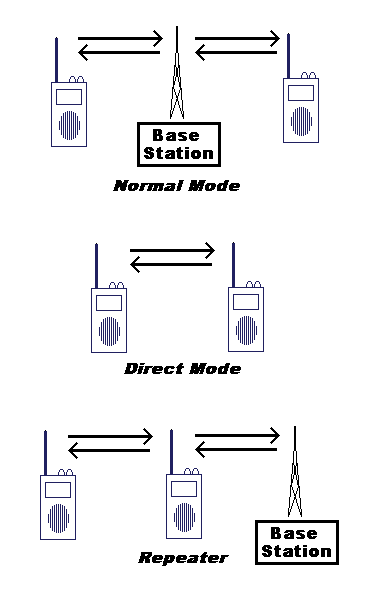
The TETRA standard supports two types of data connections, a continuous circuit (like a telephone modem) and packetized data based on the common Internet Protocol (IP). These connections are intended for the delivery of everything from short messages to fingerprint data and mug shot pictures, maps, and even compressed camera images.
TETRA uses a technique called Time Division Multiple Access (TDMA) to squeeze four users into a single 25 kHz radio channel. Rather than allowing a single user to transmit continuously on a radio channel, TDMA radios rapidly take turns transmitting and receiving. In a TETRA system each user is assigned one of four timeslots that are each exactly 14.167 milliseconds long. The user in timeslot 1 will transmit for 14 milliseconds, then stop. The user in timeslot 2 then takes his turn, transmitting for 14 milliseconds. The third and fourth users take their turns, and then the user in timeslot 1 can transmit again. Four timeslots together constitute a frame and take a total of 56.668 milliseconds to complete.
In the brief period of time a radio has to transmit, it can transfer data at an effective rate of 7,200 bits per second. The four channels together have a combined rate of 28,800 bits per second, roughly equivalent to a normal dial-up modem you may have connected to your computer. If a particular user needs to move a lot of information and some of the other timeslots are not being used, TETRA can combine timeslots and effectively increase the radio's data throughput.
The information transmitted by the radio may include Internet Protocol packet data, the digitized output of the vocoder (voice encoder-decoder), and security codes for link encryption.
Since the radio can usually only transmit during one timeslot, it can spend the remainder of the time receiving. Just as a user has a transmit timeslot, it also has an assigned receive slot, offset in time so that a radio can alternate between transmitting and receiving. By switching back and forth between transmitting and receiving 18 times every second, a TETRA radio user has the ability to talk and listen at the same time, just like a normal telephone call (this simultaneous communication is referred to as full-duplex). Most analog and even some digital systems limit the user to either speaking or listening at any particular time (this is called half-duplex).
TETRA radios usually have built-in ETSI encryption algorithms to secure the radio link. There is also a capability to authenticate radio users, making much more difficult for criminals and pranksters to transmit on public safety networks. Radios may be remotely disabled and specific users can be uniquely identified through the use of Subscriber Identification Module (SIM) cards.
TETRA in the United States
Although Motorola is the primary vendor for Project 25 in the United States, they are also very active in selling TETRA equipment overseas. They market their TETRA standard products under the name Dimetra (Digital Mobile Enhanced Trunked Radio), offering an encrypted air interface (radio link) and direct Internet Protocol connections between mobile data terminals and fixed-location computers. Their sales pitch includes the promise that all voice, data, and signaling information traveling over Dimetra will be fully encrypted.
In December of 1999 the TETRA standard was approved as a phase 2 option for future applications in the Project 25 suite of standards.
Project 25 is defined in phases. Phase 1 specifies a Frequency Division Multiple Access (FDMA) radio interface, which is not directly compatible with TETRA. A number of phase 1 Project 25 systems are already in operation, including installations in Colorado, Connecticut, Maryland, Michigan and Virginia.
Phase 2 holds the possibility of alternative radio interfaces, including TDMA techniques like TETRA. Even if public safety agencies settle on phase 1 systems, TETRA could provide commercial network operators the ability to directly compete against the iDEN network owned by Nextel.
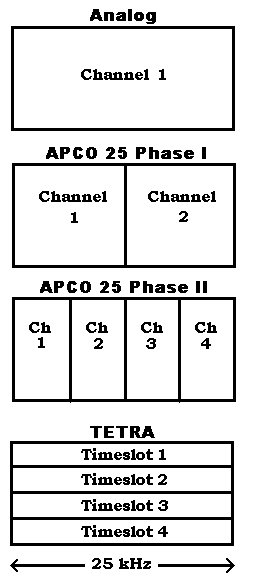
Just as there are currently no scanners that can listen to Project 25 systems, there are no publicly available TETRA scanners. However, like Project 25, the TETRA standard is open and available, so there may come a time when scanner listeners could monitor unencrypted transmissions.
FCC Database
Dan,
In the article you showed how to access the FCC database. It works all right, but my question is how come that I can not seem to get any frequencies for the counties in North Dakota?
I am looking for Police and Fire.
I thought that they had to be listed with the FCC.
Is there any other place that I can look for these frequencies?
Thank you for your time, and keep up the good work that you do for the magazine. It is a great magazine and I look forward to getting it every month.
Sincerely,
Dwight
The information is in the FCC database, it's just sometimes hard to find. I had some success locating frequency information for the city of Fargo, North Dakota, and here's how I found it.
1. Go to the main menu of the FCC database search at
gullfoss2.fcc.gov/cgi-bin/ws.exe/genmen/index.hts
2. Click on the "State/County" option in the General Menu Reports - Table of Contents.
3. Enter "ND" for your state and "Cass" for your county. Select the type of radio service you're looking for, or leave it as "All" to retrieve everything. In my search I first selected a Radio Service of "Public Safety Pool, Trunked [YW]" but there were no records found, so I went back and selected "Public Safety/Spec Emerg, 806-821/851-8 [GP]".
Click the "OK" button.
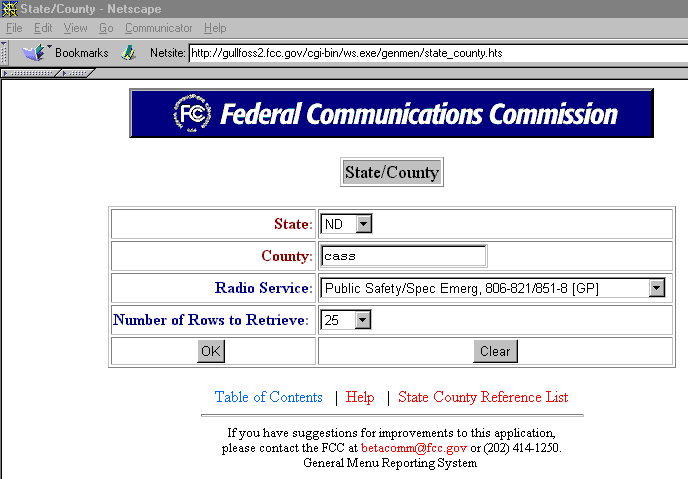
4. Click on the "ULS DATABASE" selection. (ULS stands for Universal Licensing System.)
5. Select one of the licensees that appear in the result list. I chose the city of Fargo.
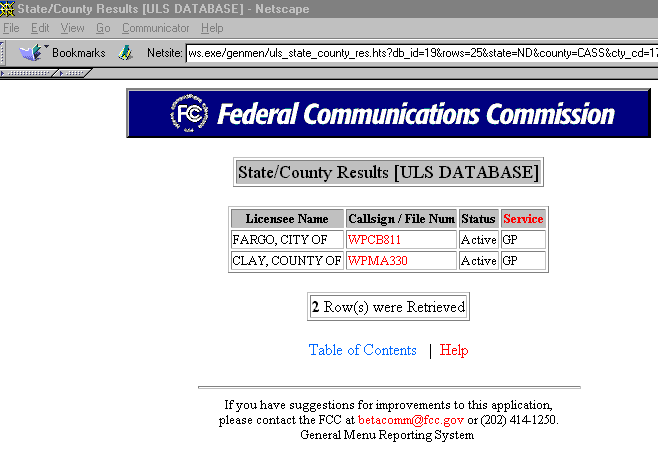
6. Click on the "SITE" selection under the "Additional" entry in the upper left corner.
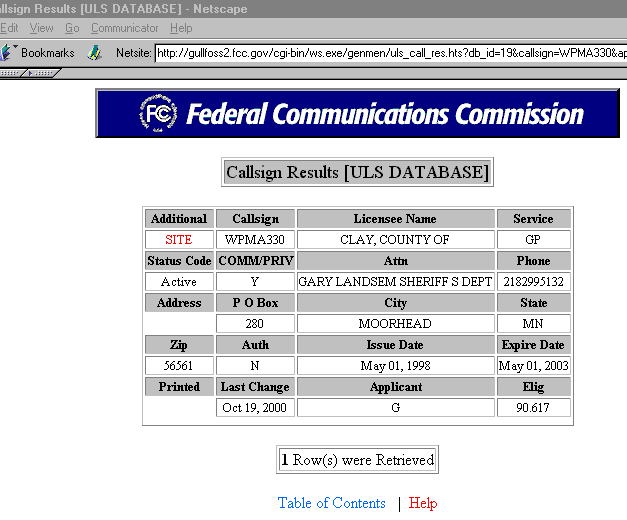
7. You should have two records. Click on the "FREQUENCY" selection under the "Additional" entry in the upper left corner of each record.
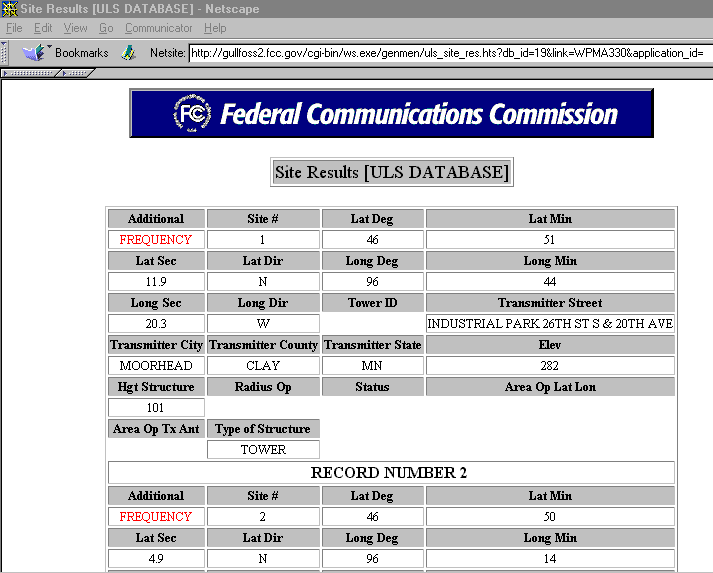
8. From this "drill-down" data you can see that the licensed frequencies are 854.9875 and 809.9875, which are the output and input, respectively, of the city repeater. Based on the single frequency and the fact that this is in the GP rather than the YW group, this is a conventional (non-trunked) system.
For other counties in North Dakota, go back to the State/County form in step 3 and enter the name of the county you'd like to search.
Dayton Hamvention
May means that the annual Hamvention in Dayton, Ohio, is almost here. This year the festivities and shopping bargains begin on Friday, May 18 and run through Sunday, May 20. There is always plenty to see and do, and many equipment manufacturers choose to announce and demonstrate new products at Dayton. More important, of course, are the thousands (yes, thousands) of outdoor flea market spots that might just have the electronic bargain you've been searching for. I highly recommend attending!
That's all for this month. You can find more information on my website at www.signalharbor.com, or send me a electronic mail at dan@signalharbor.com. Until next month, happy monitoring!